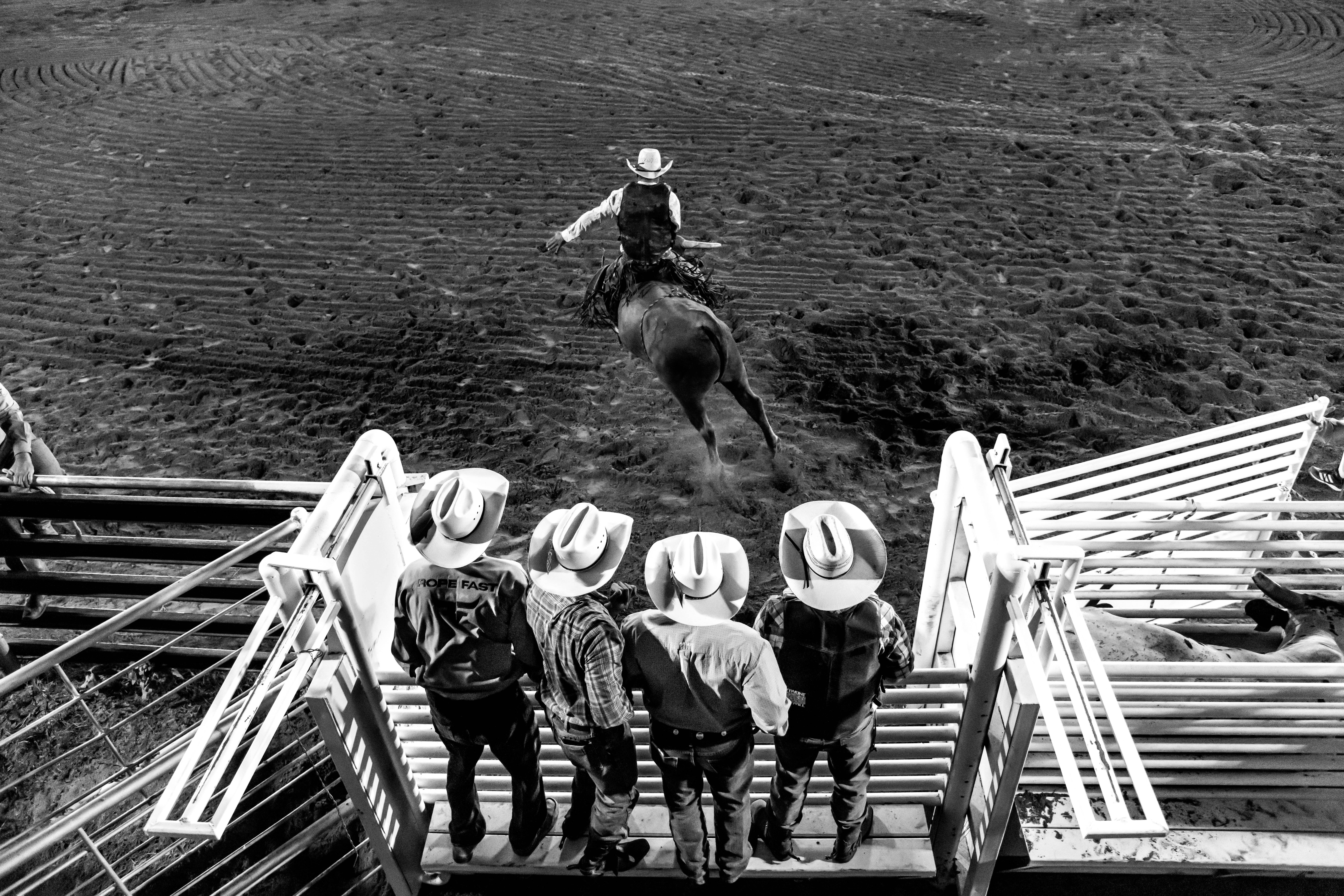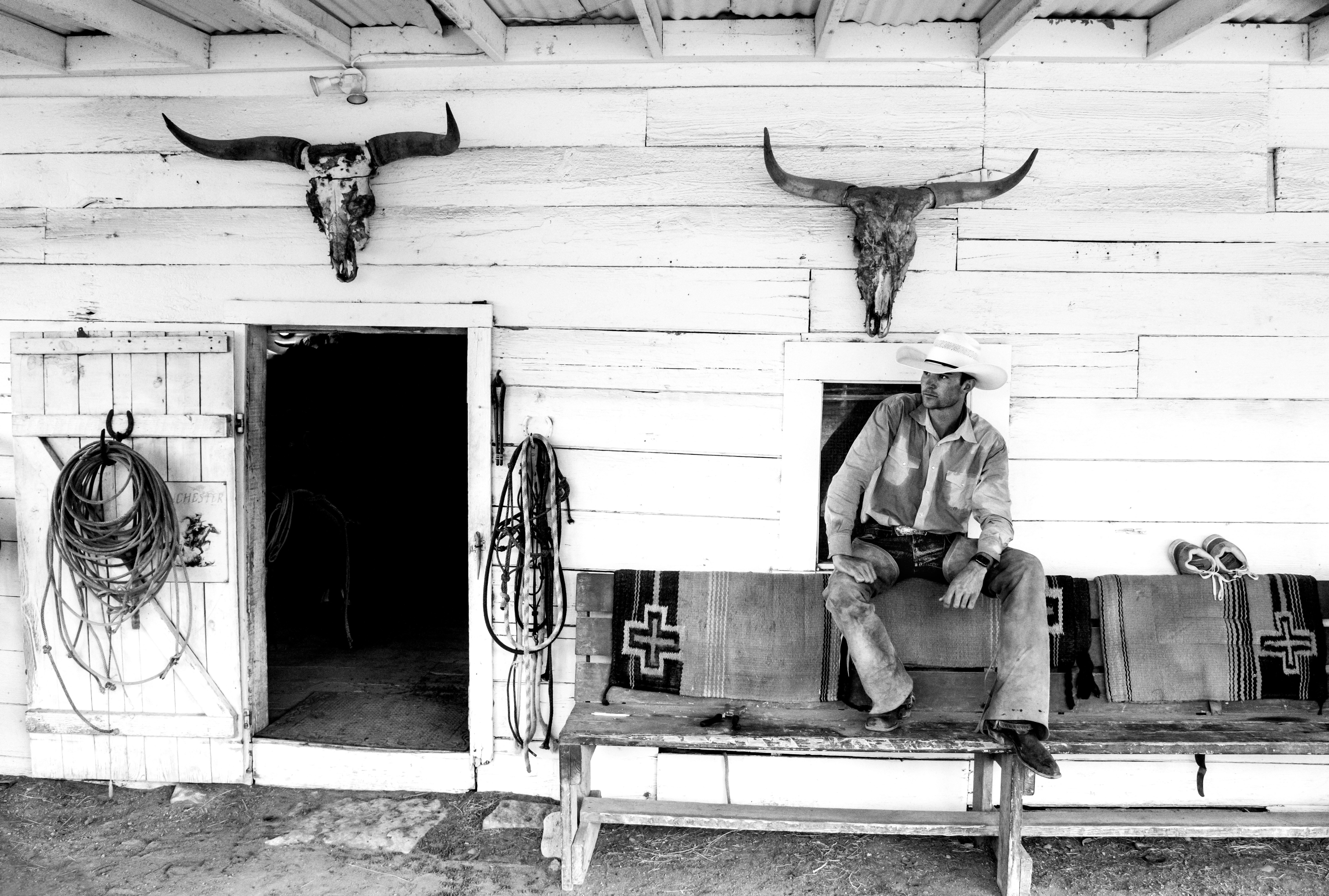French photographer Anouk Masson Krantz traveled the West to capture the everyday lives of The American Cowboy.
Even as a child growing up in France, Anouk Masson Krantz loved horses and cowboys. After she moved to the United States as an adult, her youthful passions evolved into photographic projects spanning years. Her first book, the bestselling Wild Horses of Cumberland Island, compiled a decade’s worth of photographs taken on a remote barrier island off the coast of Georgia. Her new book, WEST: The American Cowboy, offers a contemporary depiction of Western ranch and rodeo life.
“I wanted to see the lives of cowboys and ranchers firsthand so that I could share their stories from their perspective,” Krantz says. “They were surprised that I wasn’t trying to use props or asking them to pose for me. I asked them to simply go about their day as if I wasn’t there. Most of the photography is intentionally shot from behind or from a distance because I didn’t want the work to be about any one individual — it’s about the spirit of the cowboy.”
We talked with Krantz about that cowboy spirit, her experiences traveling the West, and the message of community and integrity she hopes to share through her new book.

Cowboys & Indians: You’re from France, lived and worked for a long time in New York, and are now based in Connecticut. What attracted you to the American West?
Anouk Masson Krantz: I grew up an avid horseback rider, and as a child in France, I was always intrigued by the notion of the Wild West and the American cowboy. I wanted to see for myself the vast rolling hills and expanses of ranchland underneath these enormous skies that I had heard so much about. The dramatic landscapes of the American West evoke a sense of freedom, independence, and endless possibility that has long captured the imagination of people all over the world. And I wanted to find out what life was like for those who lived and worked there.
C&I: How did the project unfold?
Krantz: My husband’s father grew up in central Kansas. When we first visited his family’s farm nearly 15 years ago, we took a few daytrips and explored the far corners of the state. As we moved further and further into the remote stretches of western Kansas, the sense of adventure and intrigue grew.
It was on one of these drives that I came across my first local rodeo. It was so uplifting to see how ranchers and farmers from far away took time out of their lives to come together and celebrate their country, their traditions, and the remarkable culture and community that they all support in their own way, each and every day. After this first experience, I always had an itch to return and learn more about their way of life. So in 2018, with a one-way ticket and my children in tow — then ages 12 and 11 — we headed to Dallas to embark upon an adventure across the great Wild West. With a rented Tahoe, a cooler, and Google Maps, we set out into the unknown. Over the course of the summer, we would cover over 6,000 miles across five states.

C&I: Your well-traveled kids still talk about this particular trip. What made it so special?
Krantz: It was the adventure of a lifetime. We didn’t stay in fancy hotels; we stuck to motels and inns. We mapped out our route by researching local attractions and keeping up with the summer rodeo calendar, staying away from the highways and instead following back roads to remote destinations. We loved the adventure, to move at our own pace, to see how different people lived, and to take in the extraordinary scenery. Throughout our journey, we were on the lookout for the American cowboy in his element, and we weren’t disappointed.
C&I: How did you go about finding people to photograph and then gain their trust for such intimate portraits?
Krantz: My goal was to photograph modern cowboys, both at work and at play. With little to go on, I started the trip with a piece of scrap paper with the name and number of someone I should reach out to. It was not easy. I could understand the resistance: Here is this outsider, a French woman from New York City who wants to get to know me and my family, asking me to open my doors so she can photograph our private lives. Why on earth would I possibly want to make time for her?
Yet, once I met that first rancher and explained that my goal was to capture the remarkable courage and beauty in the everyday lives of ranchers and cowboys, there was interest, then eventually another piece of paper and another name and number of a friend I should meet. And so it went. The spontaneity created a real sense of adventure.

C&I: Spontaneity is great, but was it always smooth sailing?
Krantz: There was one holdout in particular who made us wait in a hotel room for four nights. Every morning he had a new excuse for why he couldn’t see me. He finally gave in only when his wife convinced him: “She’s a woman. She’s with her kids, and she’s not going away. Give her a chance!” He reluctantly invited me to his home for breakfast with his family at 5 o’clock the following morning and to spend the day together. I showed up in the dark and soon found myself around a breakfast table with eight family members spanning four generations, busy preparing for a day of work on the ranch.
As you might expect, it was awkward at first. We were all smiles, polite and accommodating, while at the same time working fervently to try and figure one another out. After morning chores, we took a drive in his pickup out on the ranch to find his herd of grazing longhorns and soon found ourselves waiting out a torrential Texas summer downpour. This rainstorm was a gift from God, as it finally gave us time to begin to really talk to one another. Once I began to share my personal background, my worldview, my experiences, and my personal motivations for wanting to document and share the honest and noble lives that these cowboys live, he began to open up himself and we began to develop a true personal connection. We had more in common than we ever could have imagined, and today we are like family. We still like to laugh about this first encounter. He had his fears and misconceptions, as did I, and here our two worlds came together.
C&I: Having achieved access, connection, and even lasting friendships, what did you discover?
Krantz: I first traveled the West as an adult nearly 15 years ago, and I have since had the opportunity to visit many of the Western states. Time and time again, I return home inspired by a culture that shares a set of consistent values and by so many [people] who live with integrity in accordance with those values. The strong sense of community continues to endure, uncompromised. Out West, I feel as though I am part of something larger than just myself. These underpinnings of our great American culture are increasingly forgotten and discarded.
It’s really true that money doesn’t buy you happiness. You need it to put food on the table and keep a roof above your head, but at a certain point, you need more than material success. These people are truly happy. Their work is smelly and dirty and hot and hard and exhausting, yet they never complain. I went out on roundups with them for seven hours at a time and remember thinking, My Lord, how do they do this all the time? When I asked them, they responded, “Look at this beauty around me — look at where I get to live!” And at 6 o’clock in the morning, you look at the landscape for miles and miles and see the sun coming up over the horizon and you get it. You get why they love what they do.

C&I: How did the overall experience of the cowboy book differ from your book on the horses of Cumberland Island?
Krantz: For my book on Cumberland Island, I worked almost entirely on my own to discover and shoot extraordinary landscapes. My goal was to remind us of the beauty and inspiration that can be found in the natural world as well as within ourselves simply by unplugging from our daily habits and routines and exploring the world around us. My work out West was much different in that my aim was to capture the values and culture of a community of people who are grateful for their freedoms, who take pride in their ability to provide for themselves and for their country, and who treasure their pioneering spirit and proud heritage. Witnessing it, we cannot help but be reminded of our own heritage and reflect on how drastically the rest of our America has changed.
C&I: How did your ideas about the American West and cowboy life change?
Krantz: In Europe, the only perceptions we had of the American West were through movies or books. The West has long been misidentified as a place full of men who spit and fight and who always carry a gun — sheriffs and deputies, bank robbers and saloonkeepers. In fact, the men, women, and children of the West are honestly genuine, hardworking, generous, and authentically good people with all the right values. In their world, there is no glory or praise for singular achievements; honor is in keeping your word, contributing to community, and willingness to sacrifice. They all come together to help and support one another. They finish their job after a week on one ranch and move on to the next to get the job done there.
At the dinner table, you will find young children, teenagers, parents, and the grandparents joined together. Yes, they have their differences, but they understand that each has an important role to play. This builds a culture of us — all together — helping each other out in the community and at the same time serving the country. My work is a celebration of those values, the work ethic, the integrity, love for friends and family, community, and country, regardless of cultural background.
C&I: A departure from your life in the East?
Krantz: In the fast-paced, interconnected, and competitive world that I live in back East, it’s increasingly become about me: how big my house is, how nice my car is, how athletic my kids are, how I look, how much money I make. And my way of thinking is the only way. Over the years, this has become more and more evident across America, particularly in the big cities, where there are fewer and fewer shared values that tie us together as a community.
It’s different on the ranch, where people recognize that life is precious, that we rely upon one another for our survival, that we should remain grateful, and that we share our successes. It’s about us — there is no me. It’s wonderful, and it’s the message that I wanted to craft in my book: Get back to a focus on community, on helping one another. We need more of that in our lives.
The traveling solo exhibition WEST: The American Cowboy debuts August 22 – October 18, 2020, at the National Cowboy & Western Heritage Museum in Oklahoma City. The book (Images Publishing) is available on Amazon. Anouk Krantz is represented by galleries across the nation including Visions West Contemporary (visionswestcontemporary.com) in Jackson, Wyoming; Denver; and Bozeman and Livingston, Montana. Visit the artist online at anoukkrantz.com.
Photography: (Lead Image) The Throw; (Top to Bottom) The Crew, Bull Rider, Wrangler, Ranch Life; (Slider) Pinto Canyon, Lone Star, Rodeo Cowboy / ©Anouk Masson Krantz/Courtesy The Artist.
From the November/December issue.

















